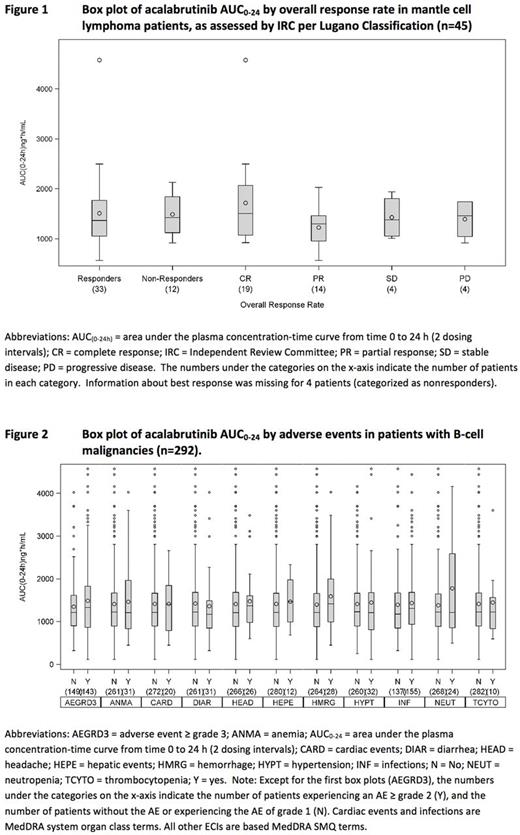Abstract

Background:
Acalabrutinib (ACP-196) is a highly selective, potent, covalent inhibitor of Bruton tyrosine kinase (BTK), in development for the treatment of hematologic malignancies. In the class of irreversible covalent binding kinase inhibitors, the duration of pharmacodynamic activity is a function of the de novo synthesis rate of the target protein, as inhibition of signal transduction is maintained until functional levels of the target kinase are restored (Barf and Kaptein 2012). Acalabrutinib has rapid absorption and a short pharmacokinetic (PK) half-life; twice daily dosing resulted in near complete and continuous BTK inhibition in patients with chronic lymphocytic leukemia (CLL) (Byrd JC, et al. 2016).
Exposure-response analysis was performed to identify potential trends in efficacy or safety that may be related to PK of acalabrutinib in patients. All patients received acalabrutinib as monotherapy. The relationship between acalabrutinib plasma exposure and efficacy was evaluated in patients with relapsed/refractory (R/R) mantle cell lymphoma (MCL). The relationship between acalabrutinib plasma exposure and safety was evaluated in patients with B-cell malignancies that included R/R MCL, chronic lymphocytic leukemia, follicular lymphoma, diffuse large B-cell lymphoma, multiple myeloma and Waldenström macroglobulinemia.
Methods:
Acalabrutinib exposure metrics included AUC0-24 and Cmax, predicted from a population pharmacokinetic analysis.
Exposure-efficacy analyses were performed using exposure metrics and overall response rate (ORR) data from a single Phase 2 study in patients with R/R MCL (n=45) receiving oral acalabrutinib at a dose of 100 mg bid. The efficacy endpoint evaluated was ORR, as assessed by an independent review committee (IRC) as well as by investigators, according to 2014 Lugano Classification.
Exposure-safety analyses were conducted using data from 6 studies in patients with B-cell malignancies (n=292) receiving oral acalabrutinib at dosages of 100, 175, 200, 250 or 400 mg qd, 100 mg bid, or 200 mg bid. A total of 180 patients received acalabrutinib 100 mg bid as a starting dosage. The safety endpoints evaluated included headache, diarrhea, and grade ≥ 3 adverse events (AE), as well as AEs of clinical interest that included anemia, cardiac events, hepatic events, hemorrhage, hypertension, infections, neutropenia, and thrombocytopenia.
Results:
Among patients with R/R MCL receiving acalabrutinib 100 mg BID, there were 45 patients with PK evaluations to support exposure-response analysis. No trends were observed between AUC0-24 and ORR, and similar median AUC0-24 was observed between responders (n=33) and non-responders (n=12; fig 1). Similar results were observed when ORR was evaluated against Cmax.
Likewise, there were no trends observed between AUC0-24 (fig 2) or Cmax and AEs across a larger dataset (N=292). For the subset of patients receiving 100 mg bid as a starting dose (N=180), acalabrutinib AUC0-24 and Cmax were comparable, whether AEs were present or absent.
Conclusion:
In n=45 R/R MCL patients receiving acalabrutinib 100 mg bid, there were no exposure-response trends observed in ORR. Across 6 studies in 292 patients with B-cell malignancies that were treated with acalabrutinib monotherapy, there were no exposure-response trends observed with safety endpoints.
In R/R MCL patients treated with 100 mg bid acalabrutinib, these results reflect the high degree of target coverage that this dose regimen provides. These data suggest that acalabrutinib exposure attained after doses up to 400 mg qd are not related to the rate of AEs in patients with B-cell malignancies. The lack of exposure-safety relationships may be attributable to the PK/PD dynamics of a highly selective covalent agent.
Jin: Theravance Biopharma: Employment. Yin: Acerta Pharma: Employment. Mandava: Acerta Pharma: Employment. Edlund: Astra Zeneca: Employment. Andrew: Acerta Pharma: Employment; Astra Zeneca: Equity Ownership. Patel: Acerta Pharma: Employment. Masson: Astra Zeneca: Employment, Equity Ownership. Al-Huniti: Astra Zeneca: Employment. Wang: Acerta Pharma: Employment, Equity Ownership. Slatter: Astra Zeneca: Equity Ownership; Acerta Pharma: Employment.
Author notes
Asterisk with author names denotes non-ASH members.

This icon denotes a clinically relevant abstract


This feature is available to Subscribers Only
Sign In or Create an Account Close Modal